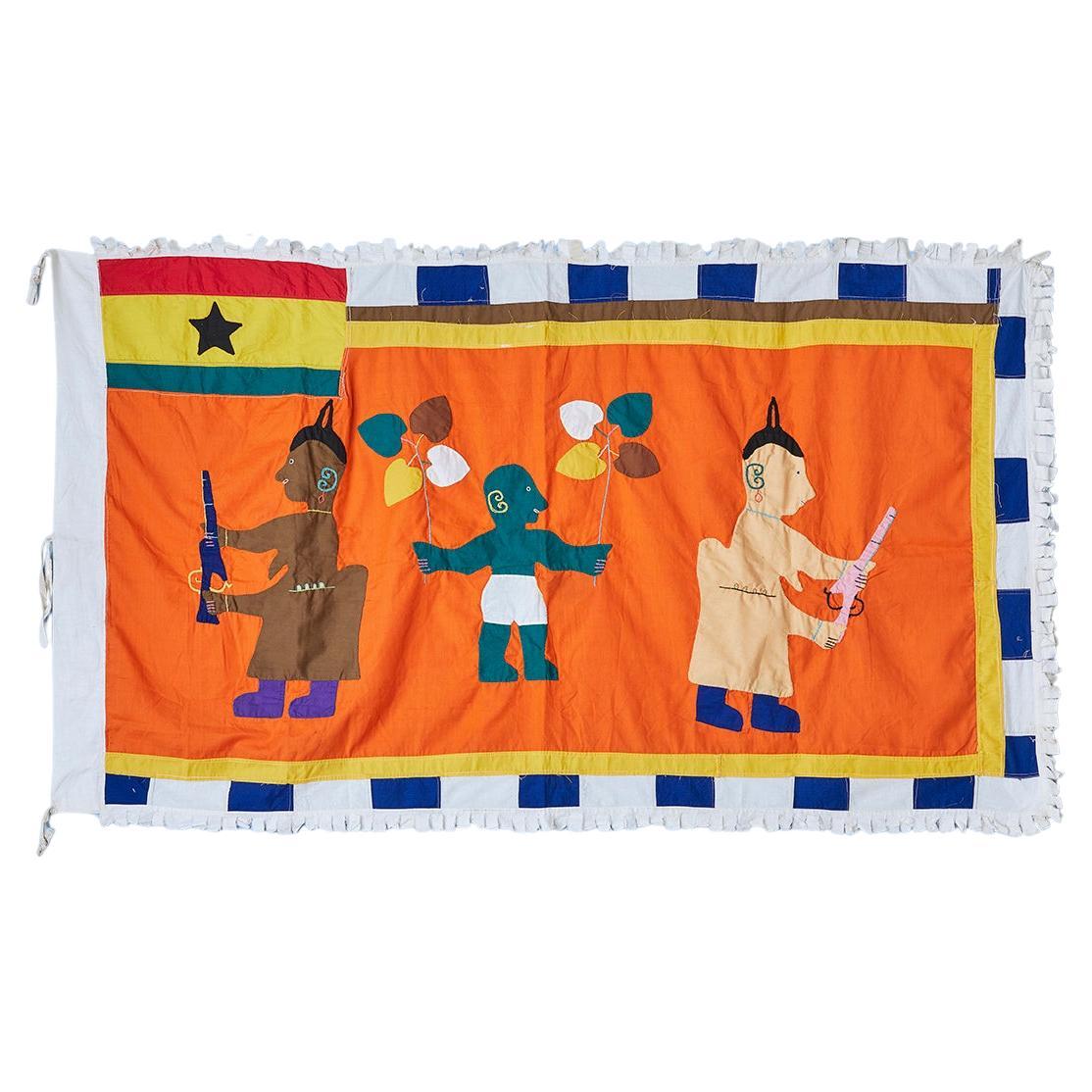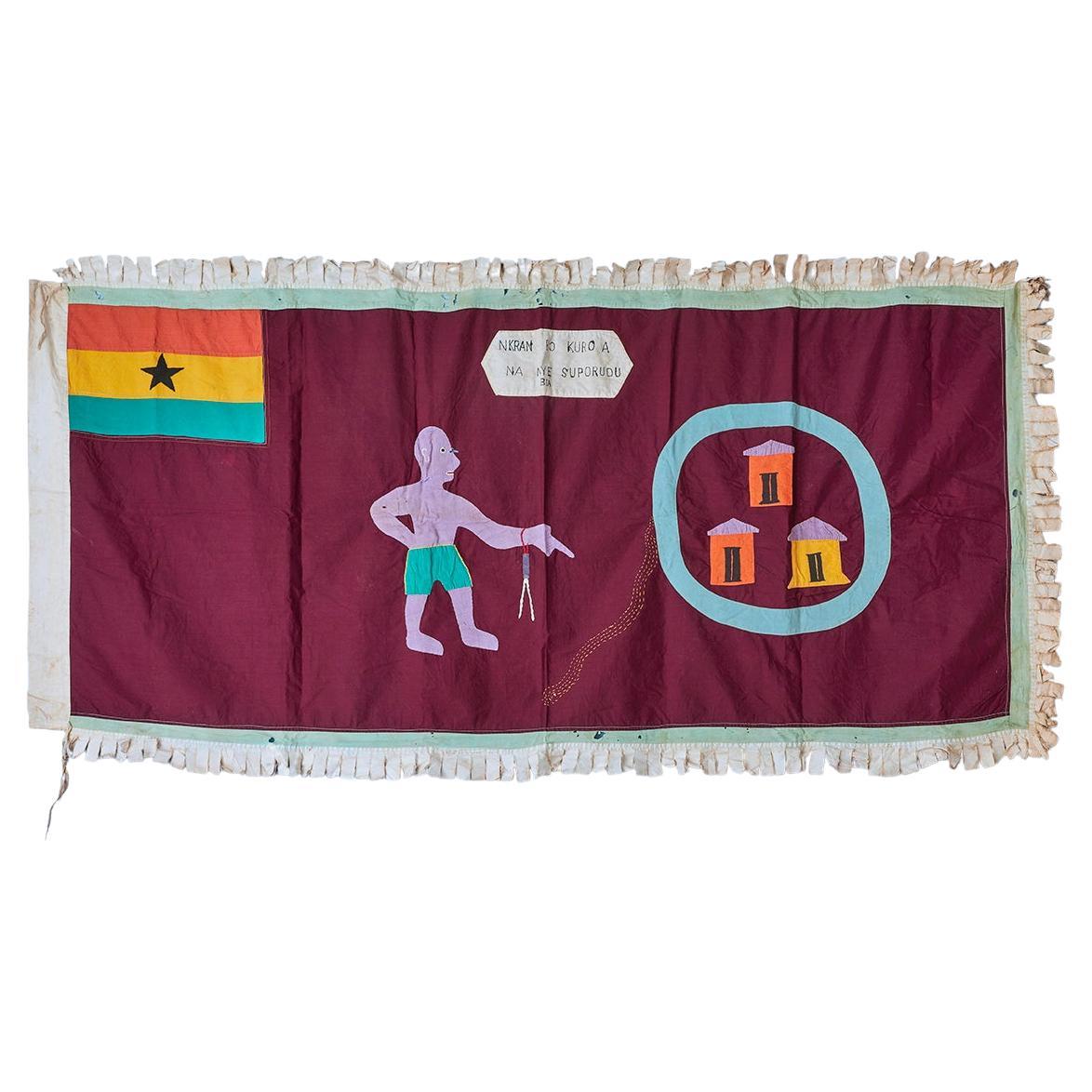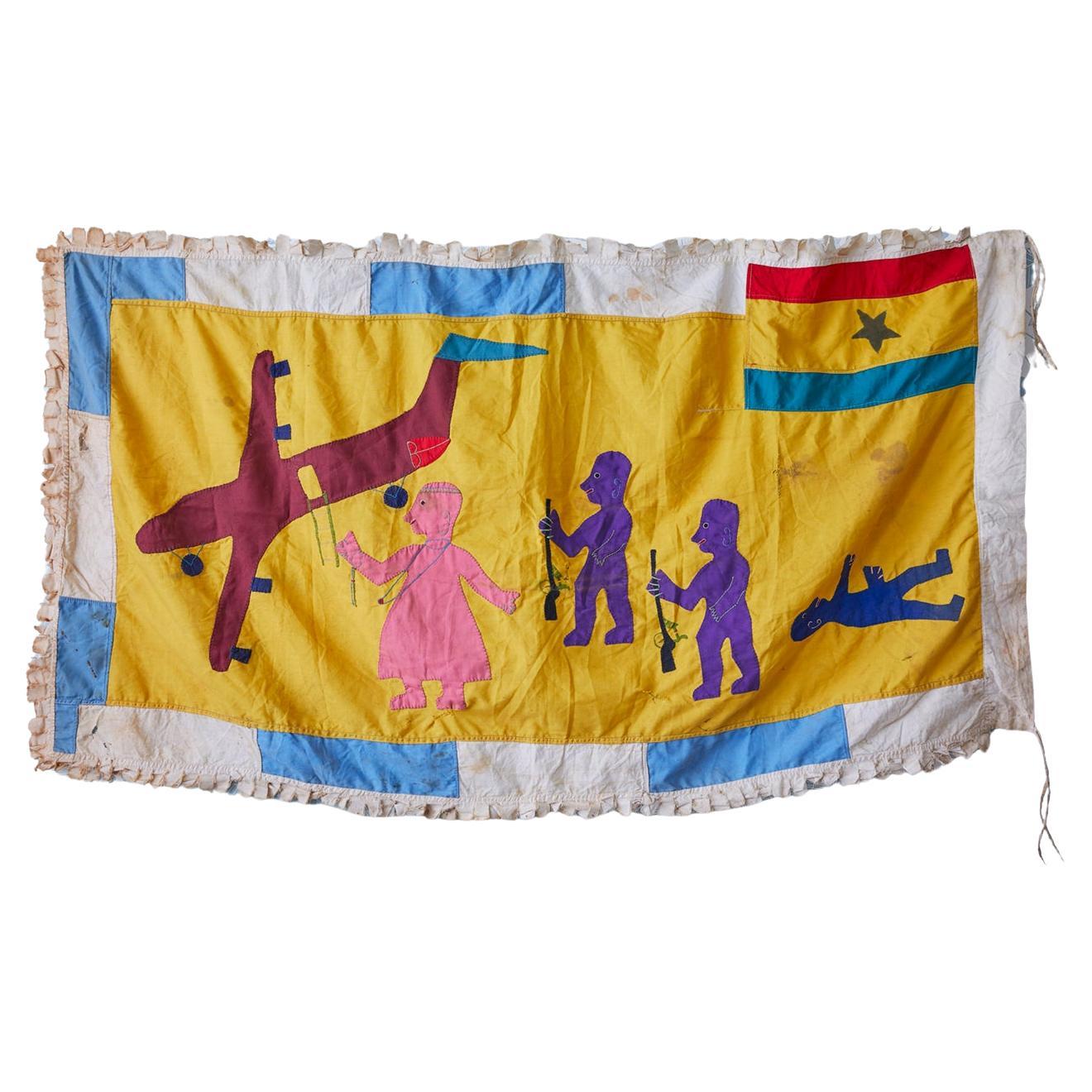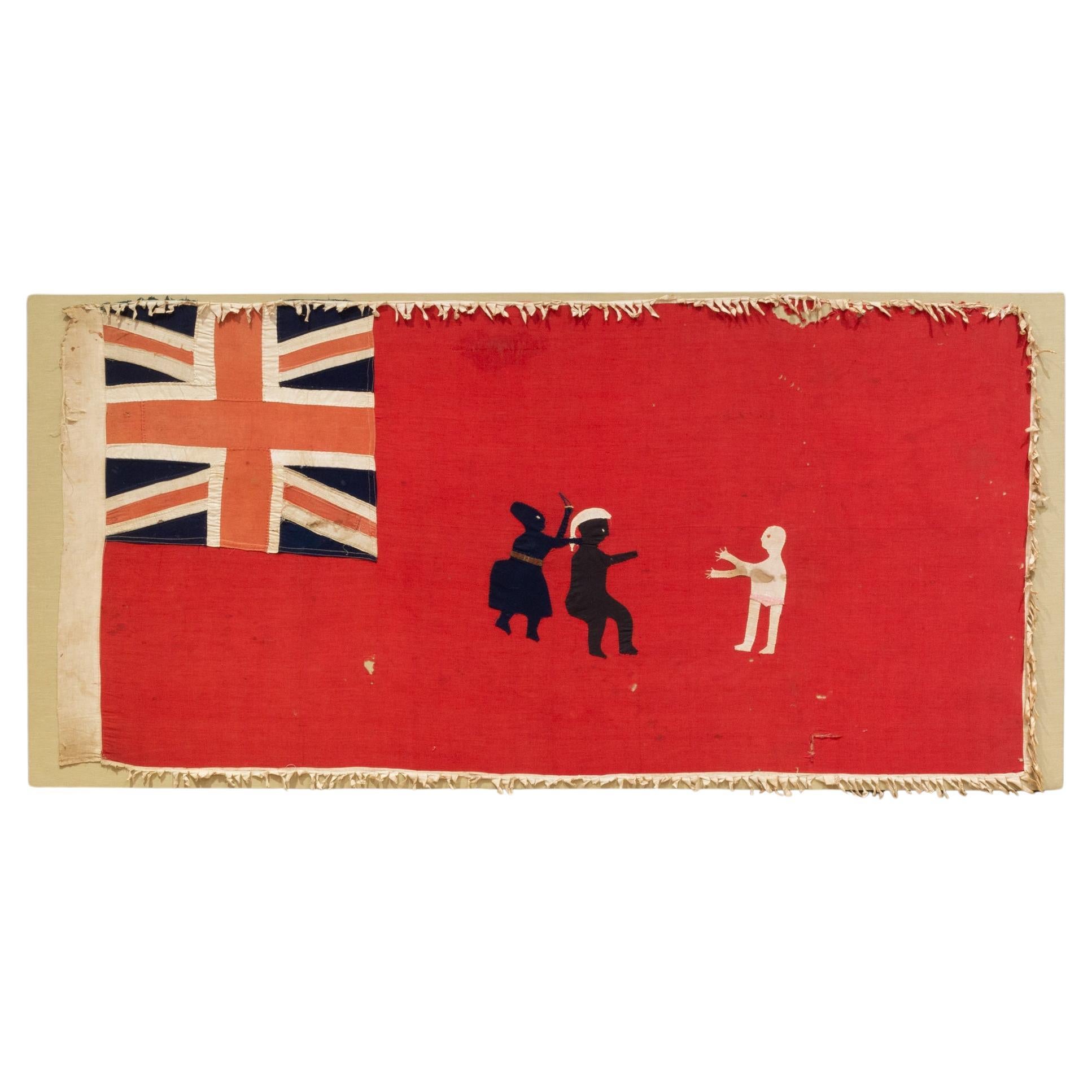Items Similar to Vintage Fante People Asafo Flag in Cotton Applique Patterns, Ghana, 1930-1950s
Want more images or videos?
Request additional images or videos from the seller
1 of 10
Vintage Fante People Asafo Flag in Cotton Applique Patterns, Ghana, 1930-1950s
About the Item
Ghana, 1930s-1950s
Asafo flag “The train is always ready to go” in cotton applique patters. Trains were a dramatic expression of power, regularity and reliability and as such were a popular theme on Fante Asafo flags after the first railway was built in Ghana in 1901. This superb flag is a very well made and charming version, dating from circa 1930-1950, made for an unidentified Number 2 Company. Condition is excellent.
Asafo flags are created by the Fante People of Ghana. The flags are visual representations of military organizations in Fante communities known as “Asafo”. The communities each have their own flag, name and number. The primary role of the “Asafo” and their flags was to exert power, political influence and maintain codes of conduct within Fante communities.
Measures: H 102 x W 130 cm.
- Creator:Fante People (Weaver)
- Dimensions:Height: 40.16 in (102 cm)Width: 51.19 in (130 cm)Depth: 0.2 in (5 mm)
- Materials and Techniques:Cotton,Appliqué
- Place of Origin:
- Period:
- Date of Manufacture:1930s-1950s
- Condition:Wear consistent with age and use.
- Seller Location:Copenhagen K, DK
- Reference Number:1stDibs: LU1011235061902
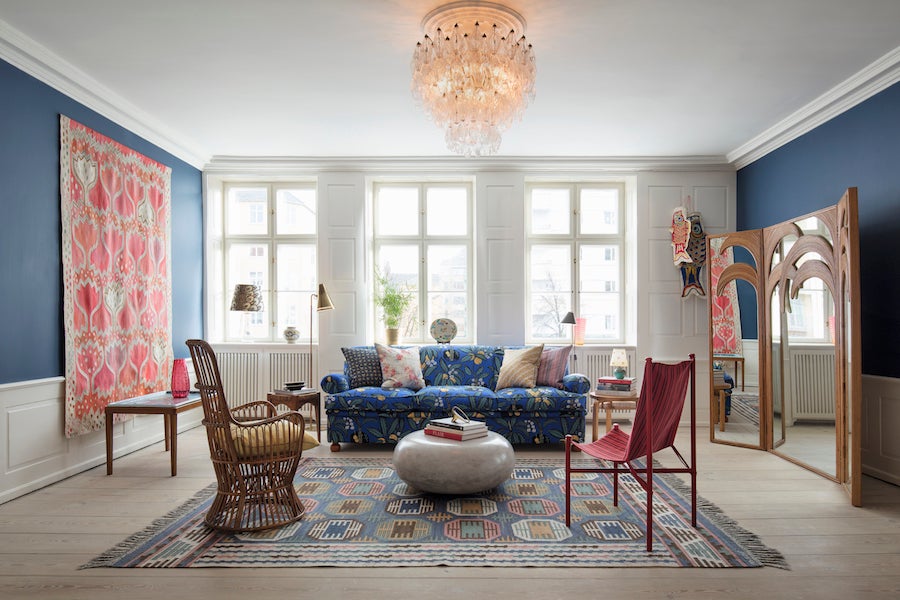
About the Seller
4.6
Vetted Seller
These experienced sellers undergo a comprehensive evaluation by our team of in-house experts.
Established in 2011
1stDibs seller since 2013
193 sales on 1stDibs
Typical response time: 2 hours
- ShippingRetrieving quote...Ships From: Copenhagen K, Denmark
- Return PolicyThis item cannot be returned.
More From This SellerView All
- Vintage Fante People Asafo Flag in Orange Cotton Appliqué Patterns, Ghana, 1970sBy Fante PeopleLocated in Copenhagen K, DKGhana, 1970s Asafo flag in cotton applique patterns. Fante People. Asafo Flags are created by the Fante people of Ghana. The flags are visual representations of military organisat...Category
Vintage 1970s Ghanaian Political and Patriotic Memorabilia
MaterialsCotton
- Vintage Asafo Flag in Pink Cotton Appliqué Pattern by Fante People, Ghana, 1960sBy Fante PeopleLocated in Copenhagen K, DKKwamina Amoaku Ghana, 1960s Asafo flag in cotton applique patterns. Fante People. Asafo Flags are created by the Fante people of Ghana. The flags are visual representations of mili...Category
Vintage 1960s Ghanaian Folk Art Political and Patriotic Memorabilia
MaterialsCotton
- Vintage Asafo Flag in Burgundy Appliqué Patterns by Fante People, Ghana, 1960sBy Fante PeopleLocated in Copenhagen K, DKGhana, 1960's Asafo flag in cotton applique patters. Fante People. Asafo Flags are created by the Fante people of Ghana. The flags are visual representations of military organisati...Category
Vintage 1960s Ghanaian More Folk Art
MaterialsCotton
- Vintage Kwamina Amoaku Asafo Flag in Cotton Appliqué Pattern, Ghana, 1960sLocated in Copenhagen K, DKKwamina Amoaku Ghana, 1960's Fante Asafo flag in cotton applique patterns. Fante People. Asafo Flags are created by the Fante people of Ghana. The flags are visual representations...Category
Vintage 1960s Ghanaian Folk Art Political and Patriotic Memorabilia
MaterialsCotton
- Vintage Fante People Asafo Flag in Yellow Cotton Appliqué Patterns, Ghana, 1980sLocated in Copenhagen K, DKGhana, 1980's Asafo flag in cotton applique patterns. Fante People. Asafo Flags are created by the Fante people of Ghana. The flags are visual representations of military organisat...Category
Vintage 1980s Ghanaian Folk Art Tribal Art
MaterialsCotton
- Vintage Red Handwoven Cotton Sash, Gutamala, 20th CenturyLocated in Copenhagen K, DKGutamala, Vintage Woven cotton sash. H 670 x W 22 cmCategory
20th Century Guatemalan Pillows and Throws
MaterialsCotton
You May Also Like
- Mounted Asafo Flag of Ghana c.1820-1920Located in San Francisco, CAABOUT Contact us for more shipping quotes: S16 Home San Francisco. An original Asafo flag depicting the Fante people of Ghana, Africa and the Union Jack of the United Kingdom. Mou...Category
Antique 19th Century Industrial Signs
MaterialsWood, Fabric
- 20th Century Fante Asafo Flag, GhanaLocated in New York, NYA large and graphically stunning Fante asafo flag. Fante flags represent the merger of two cultural traditions, the Akan tradition of combining pro...Category
Mid-20th Century Ghanaian Decorative Art
MaterialsFabric
- Mid-20th Century Fante Asafo Flag, GhanaLocated in New York, NYA large and graphically stunning asafo flag. Fante flags represent the merger of two cultural traditions, the Akan tradition of combining proverbs with ...Category
Mid-20th Century Ghanaian Tribal Art
- Patriotic Scherenschnitte In the Style Often Attributed to Isaac StiehlyLocated in York County, PAEXCEPTIONAL PATRIOTIC SCHERENSCHNITTE (PAPER CUTTING), IN THE STYLE OFTEN ATTRIBUTED TO ISAAC STIEHLY, ENTITLED “LIBERTY,” WITH IMAGERY THAT INCLUDES AN AMERICAN EAGLE WITH A 14 STAR, 14 STRIPE FLAG IN ITS BEAK, A RATTLESNAKE, LOVE BIRDS, AND EAGLES ON URNS, CA 1830-1850 This exceptional patriotic scherenschnitte was executed in the style often attributed to Pennsylvania German minister Isaac Stiehly (1800-1869). Scholars now agree that one or more artists, working in New York, were producing their own work in a very similar style. Several examples are known that bear the names of New York and/or New Jersey residents, while two, in particular, include text that celebrates the 1844 New York mayoral election victory of publishing magnate James Harper [founder of what is now Harper Collins], who ran on a ticket sponsored by the American Republican Party, a nativist organization concerned with the loss of American jobs to Irish immigrants. Note the quality of the cutwork on this example, the centerpiece of which is a large American eagle, gripping a coiled rattlesnake and holding an American flag in its beak. Above, in a lozenge-shaped medallion, the word "Liberty" is executed in large script. To the left and right of this are elaborately decorated ovals, and anchoring each corner of the work are snowflake-like medallions. To each side of the eagle, and below, is a plethora of flora and fauna, the outermost pillars of which are supported by two urns, decorated with eagles. At the bottom center is a diamond within a heart, with two doves, one of which is offering the other a leaf. Above this there are appear to be crude representations of a gnome and a fairy flanking and urn decorated with another heart, from which grow the vines in the center window. Interlocking rings decorate the border, probably to represent marriage, and it can logically be presumed that the scherenschnitte was a wedding gift. It is of interest to note that the flag displays both 14 stars and 14 stripes. Although the reason for the use of this count is unknown, on the surface it does appear to be intentional. Other known patriotic scherenschnitte display flags with various star and stripe counts. Of those I have personally owned, the one bore 14 stars and 13 stripes, another 11 stars and 13 stripes, another displayed two flags, including a 12 star flag with 14 stripes and a 14 star jack (a blue naval flag with stars but no stripes), and another, also with 2 flags, displayed a 20 star flag...Category
Antique Mid-19th Century American Political and Patriotic Memorabilia
MaterialsPaper
- Thomas Jefferson Crannock Carved CaneLocated in Darnestown, MDUnique carved cane that chronicles the life and achievements of Thomas Jefferson. Among the carved words are "Thos. Jefferson of Va Born Apr 2,1743 Wa...Category
Antique 19th Century American Country Political and Patriotic Memorabilia
MaterialsWood
- 38 Star American Flag, Stars in Notched Pattern, ca 1876-1889Located in York County, PA38 HAND-SEWN STARS IN A "NOTCHED" PATTERN, ON AN ANTIQUE AMERICAN FLAG WITH BEAUTIFUL WEAR FROM HAVING BEEN EXTENSIVELY FLOWN, MADE AT THE TIME WHEN COLORADO WAS THE MOST RECENT STATE TO JOIN THE UNION, 1876-1889 38 star Antique American flag, made during the period when Colorado was the most recent state to join the Union. The stars are arranged in what is known as a "notched" pattern, in which two spaces were left open along the hoist end, in the first and last rows, in anticipation that two more Western Territories would soon join the Union. The latter 19th century was a time of when much of the land in and about the Continental Divide was formalized into states, and there was continual speculation about which ones would be accepted next, and with what boundaries. The stars of the flag are made of cotton and are double-appliquéd (applied to both sides) with a lineal, treadle stitch. The canton and stripes of the flag are made of wool bunting that has been pieced with treadle stitching. The canton was constructed from five separate lengths of fabric, which is an unusual feature, though hardly unknown. To each of these a row of stars was sewn. This manner of construction is sometimes encountered and tends to be an early trait, at least when it occurs in flags of this scale and smaller. When encountered, it also seems to have been preferred in flags meant for maritime use. While the feature does not by any means guarantee this fact, it is a reasonable, educated guess, based upon my examination of many other examples. A flag with a 5-piece canton, such as this, would have been less likelihood to stretch, with increased structural integrity. The alternative is that this was simply an example made when there were at least five pieces of leftover fabric, of a reasonable size to made individual rows, and that what it actually demonstrates is the careful conservation of scarce resources. There is a sailcloth canvas binding along the hoist, with 3 brass grommets, evenly spaced. Perhaps the best feature of the flag is the evidence it displays of having been extensively flown, with the fly end whipped out from wind exposure. While many flags display damage from a combination of having been flown, exposure to the elements, various mishaps, and improper storage, very few exhibit wear such as this, which is both endearingly and visually attractive. This one shows its age beautifully, whipped out along the fly end, with losses that convey an element of movement, that most flags don’t capture in the state in which they survive. Colorado became the 38th state on August 1st, 1876. This was the year of our nation’s 100-year anniversary of independence. Per the Third Flag Act of 1818, stars were not officially added until the 4th of July following a state's addition. For this reason, 37 was the official star count for the American flag in 1876. Flag-making was a competitive venture, however, and few flag-makers would have been continuing to produce 37 star flags, when their competitors were making 38’s. It is for this reason that 38 and 13 stars (to represent the original 13 colonies...Category
Antique Late 19th Century American Political and Patriotic Memorabilia
MaterialsWool
Recently Viewed
View AllMore Ways To Browse
Antique Masonic Memorabilia
Antique Textiles By The Yard
James Hayes
Mens Butler
Iron Coffins
John Haley Bellamy
Recruitment Broadside
41 Star Flag
Alva Vanderbilt
Antique Hankerchief
Antique Hankerchiefs
Fabric Y The Yard
Alice Tack
Antique Hand Drill Press
Bandana Men
California Republic Flag Vintage
California Republic Vintage Flag
Eagle Of The French National Guard
